List of mammals of Florida
This is a list of mammal species found in the wild in the American State of Florida. In total, 98 species of mammals are known to inhabit, or recently to have inhabited, the state and its surrounding waters. This includes a few species, such as the black-tailed jackrabbit and red deer, that were introduced after the European colonization of the Americas. It also includes the extinct Caribbean monk seal. Rodents account for roughly one quarter of all species, followed closely by mammals from the Cetacea and Carnivora families.
The species included in this list are drawn from the work of The American Society of Mammalogists, which compiled information from five different publications.[3] Information on the international status of species has been drawn from the IUCN Red List.
Florida mammals by order
| Order | Members | Species | Threatened species |
|---|---|---|---|
| Artiodactyla | even-toed ungulates | 4 | |
| Carnivora | carnivorans | 19 | 1 |
| Cetacea | whales, dolphins and porpoises | 21 | 5 |
| Chiroptera | bats | 18 | 2 |
| Cingulata | armadillos | 1 | |
| Didelphimorphia | common opossums | 1 | |
| Lagomorpha | hares, rabbits and pikas | 4 | |
| Primates | lemurs, monkeys, and apes | 1 | |
| Rodentia | rodents | 23 | 1 |
| Sirenia | aquatic herbivorous mammals | 1 | 1 |
| Soricomorpha | shrews, moles and solenodons | 5 | |
| Total | 98 | 10 | |
Florida terrestrial mammals
Carnivora

The coyote arrived in northern Florida in the 1970s as its natural range expanded. Illegal releases were another factor in its occupation of the state. Coyotes are extremely adaptable, living in all types of forests and farms.[4]
Florida has two types of foxes. The native gray fox can be found in the United States almost anywhere, except northern plains and Rockies. It is sometimes confounded with the red fox due to having patches of red hair.[5] The red fox was introduced to Florida by hunting clubs, although it may have been native in the northern panhandle. Its preferred habitats are open areas, while the gray fox prefers woods.[6]
Red wolves were once common throughout the southeastern US, including Florida. Extinct in the wild in 1980, it has been progressively introduced to select nature preserves. The present population was introduced as part of this recovery program in 1997 to the Saint Vincent National Refuge;[7] once red wolf pups reach 18 months, they are relocated to the North Carolina portion of the program.[8]
Bobcats are well adapted to urban development and are not a conservation concern. They make their home in hammocks, forests or swamps.[9]
The Florida panther (Puma concolor coryi) is one of the subspecies of cougar. Its main differences from other subspecies are longer legs, smaller size and a shorter darker coat. The skull of the Florida panther is broader and flatter with highly arched nasal bones.[10] Reportedly only seventy adult animals are alive,[11] and a 1992 study estimated that the subspecies would become extinct between 2016 and 2055.[12] It was chosen in 1982 as the Florida state animal by the state's schoolchildren.[13]
It is believed that some jaguarundis were unintentionally released in the wild in the 1940s.[14] There is no evidence besides witness accounts, and the existence of jaguarandis in the state is dubious.[15]
Two of the eleven species of skunks live in Florida. Both the eastern spotted skunk and the striped skunk can be found statewide (except for the Keys).
Small populations of the Everglades mink (Mustela vison evergladensis), a subspecies of American mink, are encountered near Lake Okeechobee, and in the Big Cypress Swamp-Everglades National Park area.[16]
Northern river otters are a common sight close to freshwater streams across Florida. The population is increasing.[17]
Raccoons are prevalent in the lower 48 states, including Florida. Adaptable to almost all kinds of habitats, the animals are among the few who actually benefit from human development, since food becomes more available. Attacks by predators like the bobcat cause minimum mortality, and the main reason for raccoon deaths is considered to be car accidents.[18] They are regarded as predators of sea turtles nests.[19]
All Florida black bear in Florida are part of the subspecies Ursus americanus floridanus. Differences between subspecies are very small; the Florida black bear differs from other subspecies by its highly arched forehead and its long and narrow braincase.[20] Estimates for 2002 indicated the number of bears statewide to be between 2,000 and 3,200 individuals, indicating an increase from the previous census in 1998. The biggest cause of concern is roadkill, although the rates of mortality are equivalent to other areas in the country.[21]
| Name | Species/Authority | Order | Family | ASM state status and native range[3] | Red List |
|---|---|---|---|---|---|
Coyote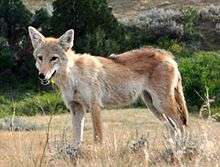 | Canis latrans Say, 1823 | Carnivora | Canidae | uncommon or locally common statewide | |
Feral dog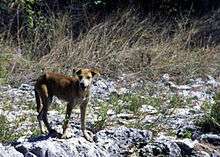 | Canis familiaris Linnaeus, 1758 | Carnivora | Canidae | locally common; escaped or released statewide | |
Gray fox | Urocyon cinereoargenteus (Schreber, 1775) | Carnivora | Canidae | uncommon or locally common statewide | |
| Red fox | Vulpes vulpes Linnaeus, 1758 | Carnivora | Canidae | uncommon or locally common statewide | |
Red wolf.jpg) | Canis rufus Audubon & Bachman, 1851 | Carnivora | Canidae | rare, introduced on Saint Vincent Island | |
Bobcat | Lynx rufus (Schreber, 1777) | Carnivora | Felidae | common; Peninsula and Northern Keys | |
Florida panther | Puma concolor (Linnaeus, 1771) | Carnivora | Felidae | rare, restricted to Green Swamp and Big Cypress areas in SW peninsula | |
Feral cat | Felis catus Schreber, 1775 | Carnivora | Felidae | abundant; escaped or released statewide | |
Jaguarundi | Herpailurus yaguarondi (Lacépède, 1809) | Carnivora | Felidae | possibly introduced to the northern two thirds of peninsula | |
Eastern spotted skunk.jpg) | Spilogale putorius (Linnaeus, 1758) | Carnivora | Mephitidae | common; statewide except northeast corner and Keys | |
Striped skunk | Mephitis mephitis (Schreber, 1776) | Carnivora | Mephitidae | common; statewide except Keys | |
Long-tailed weasel | Mustela frenata Lichtenstein, 1831 | Carnivora | Mustelidae | rare; statewide except Everglades and Keys | |
| Mink | Mustela vison Schreber, 1777 | Carnivora | Mustelidae | rare; coastal marshes in west Panhandle, Big Bend area, northeast area, and Everglades | |
Northern river otter.jpg) | Lontra canadensis (Schreber, 1777) | Carnivora | Mustelidae | locally common, mostly freshwater habitats, primarily rivers and streams, statewide except Keys | |
Common raccoon.jpg) | Procyon lotor (Linnaeus, 1758) | Carnivora | Procyonidae | abundant, statewide | |
White-nosed coati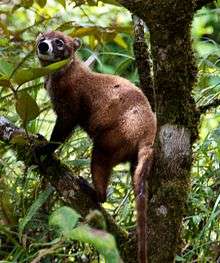 | Nasua narica (Linnaeus, 1766) | Carnivora | Procyonidae | introduced species, with reports over a wide area of southern Florida | |
Florida black bear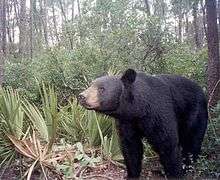 | Ursus americanus Pallas, 1780 | Carnivora | Ursidae | rare or uncommon; localized populations statewide except Keys |
Chiroptera
Of the species listed below, 13 are confirmed to be resident species; all of them are insectivorous. Five species had very low numbers reported and can be classified as accidental species: Indiana bat, Jamaican fruit bat, little brown bat, northern long-eared myotis and the silver-haired bat. Some bats not in this list, but with reported sightings in the Lower Keys, are the buffy flower bat, Cuban flower bat and Cuban fig-eating bat.[37]
Bats can be classified in two groups by their roosting habits: solitary and colony-roosting bats.
Solitary bats prefer to live in leaves, palm fronds and Spanish moss. Resident bats in this category are the Eastern red bat, the northern yellow bat and the Seminole bat. Hoary bats are not considered residents because they migrate to Mexico and South America to spend the winter.[38]
The remaining species are considered to be colony-roosting bats. Darker than their solitary counterparts and less furry, these bats prefer to live under bridges, in tree holes or caves. Only 3 Florida species live in caves: the eastern pipistrelle, the gray bat and the southeastern myotis. Florida has the highest concentration of southeastern myotis in the world.[38]
The greatest threat to bats in Florida is the disturbance or destruction of roost sites, due to vandalism or urban development.[38]
| Name | Species/Authority | Order | Family | ASM state status and native range[3] | Red List |
|---|---|---|---|---|---|
Velvety free-tailed bat | Molossus molossus (Pallas, 1766) | Chiroptera | Molossidae | rare; Lower Keys | |
Mexican free-tailed bat | Tadarida brasiliensis (I. Geoffroy, 1824) | Chiroptera | Molossidae | common, statewide except for Keys | |
| Wagner's bonneted bat | Eumops glaucinus (Wagner, 1843) | Chiroptera | Molossidae | rare, found only in the Miami and Coral Gables area | |
Jamaican fruit bat | Artibeus jamaicensis Leach, 1821 | Chiroptera | Phyllostomidae | rare, Lower Keys only | |
Big brown bat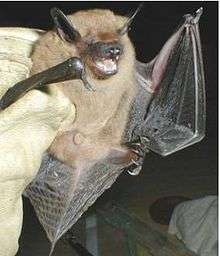 | Eptesicus fuscus (Beauvois, 1796) | Chiroptera | Vespertilionidae | common statewide except for Keys | |
Eastern pipistrelle | Pipistrellus subflavus (F. Cuvier, 1832) | Chiroptera | Vespertilionidae | uncommon; panhandle and northern half of peninsula | |
Eastern red bat | Lasiurus borealis (Müller, 1776) | Chiroptera | Vespertilionidae | uncommon; panhandle and northern quarter of peninsula | |
| Evening bat | Nycticeius humeralis (Rafinesque, 1818) | Chiroptera | Vespertilionidae | common; statewide except for Keys | |
Gray bat | Myotis grisescens A.H. Howell, 1909 | Chiroptera | Vespertilionidae | rare, known only from panhandle, Marianna area | |
Hoary bat | Lasiurus cinereus (Beauvois, 1796) | Chiroptera | Vespertilionidae | uncommon, panhandle and northern half of peninsula | |
Indiana bat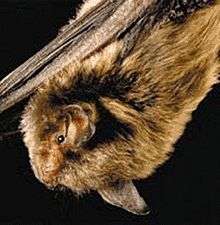 | Myotis sodalis Miller & Allen, 1928 | Chiroptera | Vespertilionidae | rare, known only from panhandle, Marianna and Jackson counties | |
Little brown bat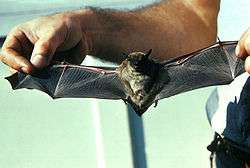 | Myotis lucifugus (La Conte, 1831) | Chiroptera | Vespertilionidae | rare, known only from panhandle and Okaloosa County | |
Northern long-eared myotis | Myotis septentrionalis (Trouessart, 1897) | Chiroptera | Vespertilionidae | rare, known only from panhandle, Marianna and Jackson counties | |
| Northern yellow bat | Lasiurus intermedius H. Allen, 1862 | Chiroptera | Vespertilionidae | common statewide except southern tip of peninsula and Keys | |
| Rafinesque's big-eared bat | Plecotus rafinesquii Lesson, 1827 | Chiroptera | Vespertilionidae | rare, statewide except southern tip of peninsula and Keys | |
Seminole bat.jpg) | Lasiurus seminolus (Rhoads, 1895) | Chiroptera | Vespertilionidae | common, statewide except southern tip of peninsula and Keys | |
Silver-haired bat | Lasionycteris noctivagans (La Conte, 1831) | Chiroptera | Vespertilionidae | rare; known only from north Santa Rosa County and possibly north Nassau County | |
Southeastern myotis | Myotis austroriparius (Rhoads, 1897) | Chiroptera | Vespertilionidae | common; cave habitats in panhandle and, disjunct, northeastern and northcentral peninsula |
Rodentia
Of the several species of rodents in Florida, the subspecies of oldfield mouse are the biggest conservation concern, along with the Florida mouse. Six of eight subspecies of the Oldfield mouse (commonly named beach mice) are in endangered status, and one is extinct. Given causes for their demise is predators like cats and red foxes and destruction of their natural habitats.[57] The Florida mouse is on the endangered species list because of destruction of their habitat. The mouse is the only mammal that is endemic to Florida. The rodent depends on the gopher tortoise (also endangered) for its survival, because it makes its burrows from tortoise burrows, or in the absence of those, Oldfield mouse burrows.[58]
Non-native species brought in boats by colonizers are the black rat, brown rat and house mouse. Other non-natives are the capybara, the nutria and the Mexican gray squirrel.[59]
Not listed below, but with reported sightings, are the biggest rat in the world, the Gambian pouched rat, which arrived in 2002; and the prairie dog. Both are wild releases of animals kept as pets.[59]
| Name | Species Authority | Order | Family | ASM state status and native range[3] | Red List |
|---|---|---|---|---|---|
American beaver | Castor canadensis Kuhl, 1820 | Rodentia | Castoridae | common; panhandle and northern third of peninsula, except coastal areas. | |
| Southeastern pocket gopher | Geomys pinetis Rafinesque, 1817 | Rodentia | Geomyidae | common; panhandle and northern half of peninsula | |
Capybara | Hydrochaeris hydrochaeris (Linnaeus, 1766) | Rodentia | Hydrochaeridae | introduced; probably several small populations north of peninsula | |
Oldfield mouse | Peromyscus polionotus (Wagner, 1843) | Rodentia | Cricetidae | rare; coastal dunes and dunes on some barrier islands; uncommon on panhandle and northern two thirds of peniinsula in dry, sandy, oldfields and grasslands | |
Cotton mouse | Peromyscus gossypinus (Le Conte, 1850) | Rodentia | Cricetidae | common; statewide in forests and mixed forest/grasslands | |
Eastern harvest mouse | Reithrodontomys humilis (Audubon & Bachman, 1941) | Rodentia | Cricetidae | common; panhandle and northern two thirds of peninsula in oldfields, grasslands, and fields | |
Florida woodrat | Neotoma floridana (Ord, 1818) | Rodentia | Cricetidae | uncommon; panhandle, northern two thirds of peninsula and rare; Key Largo | |
| Florida mouse | Podomys floridanus (Chapman, 1889) | Rodentia | Cricetidae | rare; central peninsula, mostly in habitats along central ridges. | |
Meadow vole | Microtus pennsylvanicus (Ord, 1815) | Rodentia | Cricetidae | rare; salt marsh in Cedar Key area of Gulf coast | |
| Golden mouse | Ochrotomys nuttalli (Harlan, 183)2 | Rodentia | Cricetidae | rare; panhandle and northern half of peninsula | |
Hispid cotton rat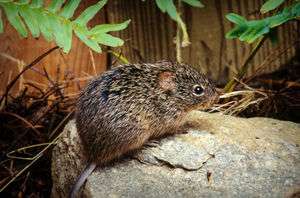 | Sigmodon hispidus Say & Ord, 1825 | Rodentia | Cricetidae | common; statewide | |
House mouse | Mus musculus Linnaeus, 1758 | Rodentia | Muridae | introduced; common; statewide | |
Marsh rice rat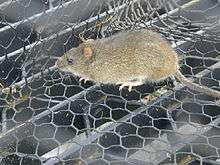 | Oryzomys palustris (Harlan, 1837) | Rodentia | Cricetidae | common; statewide in saltmarsh and associated habitats | |
Brown rat | Rattus norvegicus (Berkenhout, 1769) | Rodentia | Muridae | introduced; common; statewide | |
Woodland vole | Microtus pinetorum (Le Conte, 1830) | Rodentia | Cricetidae | uncommon; central portion of northern third of peninsula | |
Black rat | Rattus rattus (Linnaeus, 1758) | Rodentia | Muridae | introduced; common statewide | |
Round-tailed muskrat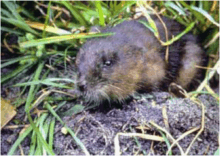 | Neofiber alleni True, 1884 | Rodentia | Cricetidae | common; peninsula and isolated populations in Apalachicola and Okefenokee areas | |
Coypu | Myocastor coypus (Molina, 1782) | Rodentia | Myocastoridae | introduced; Duval County and panhandle populations; possibly established statewide except Keys | |
Eastern chipmunk | Tamias striatus (Linnaeus, 1758) | Rodentia | Sciuridae | uncommon; northern half of western panhandle in mesic forest areas | |
Eastern gray squirrel | Sciurus carolinensis Gmelin, 1788 | Rodentia | Sciuridae | common; statewide except lower Keys | |
Fox squirrel.jpg) | Sciurus niger Linnaeus, 1758 | Rodentia | Sciuridae | rare; statewide except Keys; possibly extinct in southeastern peninsula | |
Mexican gray squirrel | Sciurus aureogaster F. Cuvier, 1829 | Rodentia | Sciuridae | introduced; established on Elliott Key | |
Southern flying squirrel | Glaucomys volans (Linnaeus, 1758) | Rodentia | Sciuridae | common; statewide except Keys and possibly southwest peninsula |
Other orders

The only native even-toed ungulate is the white-tailed deer. It is the most economically important hunting mammal in all of North America, and is one of the major prey animals of the Florida panther. There were only about 20,000 deer in Florida during the late 1930s, and the species was almost extinct in South Florida due to a campaign to eliminate tick-borne diseases. Hunt restraining measures and purchases from other states were very successful bringing the population to more than 700,000 deer statewide. The smaller subspecies, Key deer, lives only in the Keys and numbers around 800 animals.[83] Sambar deer were introduced in 1908 as alternative game for hunters on Saint Vincent Island. The population is between 700 and 1,000 deers; 130 hunters are licensed per year, and each can kill up to two animals.[84] Some red deer were released from a hunting ranch around 1967 and may still exist as a small herd.[85]
Hogs found their way to Florida in 1539 with Spanish colonist Hernando de Soto. Florida has 12% of the three million hogs that roam in the US.[86] They are a popular hunting prey, but are regarded as a pest due to the damage they inflict to agriculture and environment. More than 21,000 hogs were killed in 1980 alone.[87]
All the confirmed Soricomorpha in Florida are nocturnal; the black-tailed jackrabbit—introduced as a training tool for racing greyhounds from 1930 to 1950; the native eastern cottontail, which can be found anywhere but in forests and coastal marshes; and the marsh rabbit, who prefers freshwater and brackish marshes. The subspecies Lower Keys marsh rabbit has the scientific name Sylvilagus palustris hefneri after Hugh Hefner—because research on the subspecies was financed in part by the Playboy Foundation.[88]
Three species of shrews are found across Florida. Two known subspecies are the Homosassa shrew (Sorex longirostris eionis) and Sherman's short-tailed shrew, Blarina carolinensis shermanii.[89] One of their main predators is the cat. Completing the Soricomorpha are two species of moles.
The rhesus macaque was introduced to Florida in 1933, as props for Tarzan movies, and have established colonies after escaping from the set.[90] Charles River Laboratories, the world's biggest producer of lab animals, maintained a free-range colony until 1999, when they were forced to remove the animals after they destroyed parts of the mangrove forests in Key Haven.[91] Other primates with reported sightings not included in this list are vervet monkeys[92] and squirrel monkeys.[93]
Cingulata are represented by the nine-banded armadillo, released in 1922 by a Marine who kept them as pets, but other accounts place them as having migrated from Texas. Subsequent introductions and fast breeding spread the species statewide.[87]
The Virginia opossum is the only marsupial found in North America north of the Rio Grande. It lives in wooded areas and can be easily found statewide.
| Name | Species Authority | Order | Family | ASM state status and native range[3] | Red List |
|---|---|---|---|---|---|
Red deer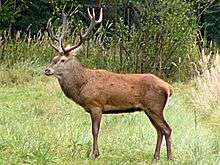 | Cervus elaphus Linnaeus, 1758 | Artiodactyla | Cervidae | introduced; single population in Highlands County. | |
| Sambar deer | Cervus unicolor Kerr, 1792 | Artiodactyla | Cervidae | introduced on St. Vincent Island | |
White-tailed deer | Odocoileus virginianus Zimmermann, 1780 | Artiodactyla | Cervidae | common statewide; rare in Keys | |
Feral pig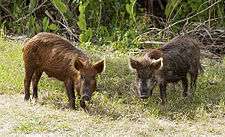 | Sus scrofa Linnaeus, 1758 | Artiodactyla | Suidae | common; statewide except Keys | |
Nine-banded armadillo | Dasypus novemcinctus Linnaeus, 1758 | Cingulata | Dasypodidae | common; statewide, except possibly some parts of Everglades | |
Virginia opossum | Didelphis virginiana Kerr, 1792 | Didelphimorphia | Didelphidae | common; statewide | |
Black-tailed jackrabbit | Lepus californicus Gray, 1837 | Lagomorpha | Leporidae | introduced; established in Homestead area | |
Eastern cottontail.jpg) | Sylvilagus floridanus (J.A. Allen, 1890) | Lagomorpha | Leporidae | common; statewide except Keys | |
Marsh rabbit | Sylvilagus palustris (Bachman, 1837) | Lagomorpha | Leporidae | common; statewide | |
Swamp rabbit | Sylvilagus aquaticus (Bachman, 1837) | Lagomorpha | Leporidae | rare and unconfirmed; possibly present in Escambia County but no known records | |
Rhesus macaque | Macaca mulatta (Zimmermann, 1780) | Primates | Cercopithecidae | introduced; Ocala and Silver Springs area | |
| North American least shrew | Cryptotis parva (Say, 1823) | Soricomorpha | Soricidae | common; statewide except for Keys | |
Southeastern shrew | Sorex longirostris Bachman, 1837 | Soricomorpha | Soricidae | uncommon; north, south through Central Florida and on central ridge through southcentral | |
Southern short-tailed shrew | Blarina carolinensis (Bachman, 1837) | Soricomorpha | Soricidae | common; statewide except for Keys | |
Eastern mole | Scalopus aquaticus (Linnaeus, 1758) | Soricomorpha | Talpidae | common; statewide except for Keys | |
Star-nosed mole | Condylura cristata (Linnaeus, 1758) | Soricomorpha | Talpidae | rare; Okefenokee Swamp area and possibly in Leon County |
Florida marine mammals
Carnivora and Sirenia

Trichechus manatus latirostris is one of the two subspecies of the West Indian manatee. This herbivorous aquatic mammal lives in rivers, springs and shallow coastal waters. It was designated the state marine mammal in 1975[110] and is protected by federal and state laws. Threatened by habitat loss, entanglements in fishing gear and crab traps, or by being asphyxiated or crushed by canal locks and flood gates, the most common cause for manatee deaths is being struck by boats, which caused one quarter of all deaths recorded since 1974. In 2015, the statewide population was estimated at 6,063.[111]
Florida does not have seal colonies, but stray seals wash ashore in Florida occasionally. The most prevalent of those species have been the common seal and the hooded seal, although a bearded seal was seen in 2007.[112] The Caribbean monk seal was native to the Caribbean Sea and the Gulf of Mexico. Once a popular prey for Bahamas fishermen, their numbers diminished greatly in the 1800s. The last sighting of the species in Florida was in 1922, and specimens have not been seen anywhere since 1952.[113]
| Name | Species/Authority | Order | Family | ASM state status and native range[3] | Red List |
|---|---|---|---|---|---|
Harbor seal | Phoca vitulina Linnaeus, 1758 | Carnivora | Phocidae | rare; east coastal marine areas to Central Florida | |
Hooded seal | Cystophora cristata (Erxleben, 1777) | Carnivora | Phocidae | rare; east coastal marine areas to Central Florida | |
Caribbean monk seal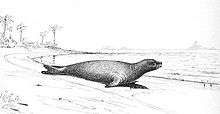 | Monachus tropicalis (Gray, 1850) | Carnivora | Phocidae | extinct | |
West Indian manatee | Trichechus manatus Linnaeus, 1758 | Sirenia | Trichechidae | rare; coastal marine areas, but not usually north of the Suwannee River in the Gulf of Mexico; enters rivers and connected springs | |
Cetacea

Of the several whales seen close to Florida, the most frequent and notable visitor is the North Atlantic right whale. Named as such because they were the "right" whales to kill, their only known calving ground is located off the coasts of Georgia and Florida. Pregnant females migrate from feeding grounds located far north and deliver calves from mid December to March.[118] Humpback whales are also re-colonizing the area while gray whales, once cavorting off Florida for the same reasons as the right whales, were extirpated from the Atlantic in the 17th-18th century.[119]
The most common dolphin in the state is the common bottlenose dolphin. Dolphins, like manatees, are vulnerable to red tide and have mass fatalities when one occurs.[120] Dolphins were designated the Florida state saltwater mammal in 1975.[121]
| Name | Species/Authority | Order | Family | ASM state status and native range[3] | Red List |
|---|---|---|---|---|---|
North Atlantic right whale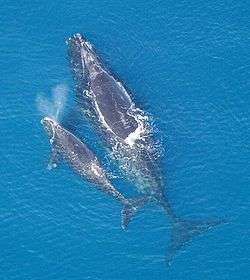 | Eubalaena glacialis P.L.S. Müller, 1776 | Cetacea | Balaenidae | regular migrant (in very small number); marine areas | |
Gray whale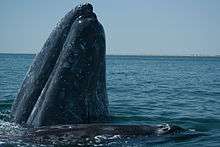 | Eschrichtius robustus Lilljeborg, 1861 | Cetacea | Balaenopteridae | extirpated in the Atlantic 17th-18th century | |
Bryde's whale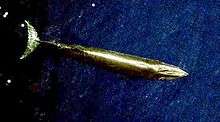 | Balaenoptera edeni Anderson, 1878 | Cetacea | Balaenopteridae | rare; marine areas | |
Fin whale | Balaenoptera physalus (Linnaeus, 1758) | Cetacea | Balaenopteridae | rare; marine areas | |
Blue whale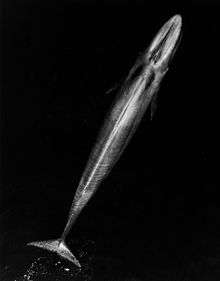 | Balaenoptera musculus (Linnaeus, 1758) | Cetacea | Balaenopteridae | rare; marine areas | |
| Common minke whale | Balaenoptera acutorostrata Lacépède, 1804 | Cetacea | Balaenopteridae | rare; marine areas | |
Sei whale | Balaenoptera borealis Lesson, 1828 | Cetacea | Balaenopteridae | rare; marine areas | |
Humpback whale | Megaptera novaeangliae (Borowski, 1781) | Cetacea | Balaenopteridae | common (in small numbers); marine areas | |
| Atlantic spotted dolphin | Stenella frontalis (G. Cuvier, 1829) | Cetacea | Delphinidae | rare; marine areas | |
Pantropical spotted dolphin | Stenella attenuata (Gray, 1846) | Cetacea | Delphinidae | rare; marine areas | |
Striped dolphin | Stenella coeruleoalba (Meyen, 1833) | Cetacea | Delphinidae | rare; marine areas | |
Clymene dolphin | Stenella clymene (Gray, 1846) | Cetacea | Delphinidae | rare; marine areas | |
Spinner dolphin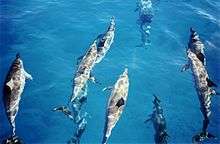 | Stenella longirostris (Gray, 1828) | Cetacea | Delphinidae | rare; marine areas | |
Common bottlenose dolphin | Tursiops truncatus (Montagu, 1821) | Cetacea | Delphinidae | common; coastal marine areas | |
Short-beaked common dolphin | Delphinus delphis Linnaeus, 1758 | Cetacea | Delphinidae | rare; marine areas | |
False killer whale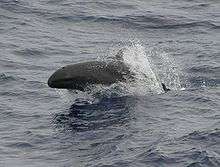 | Pseudorca crassidens (Owen, 1846) | Cetacea | Delphinidae | rare; marine areas | |
Pygmy killer whale | Feresa attenuata (Gray, 1875) | Cetacea | Delphinidae | rare; marine areas | |
Melon-headed whale | Peponocephala electra (Gray, 1846) | Cetacea | Delphinidae | rare; marine areas | |
| Fraser's dolphin | Lagenodelphis hosei (Fraser, 1956) | Cetacea | Delphinidae | rare; marine areas | |
Risso's dolphin | Grampus griseus (G. Cuvier, 1812) | Cetacea | Delphinidae | rare; marine areas | |
Killer whale | Orcinus orca (Linnaeus, 1758) | Cetacea | Delphinidae | rare; marine areas | |
Rough-toothed dolphin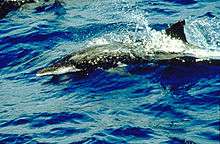 | Steno bredanensis (G. Cuvier in Lesson, 1828) | Cetacea | Delphinidae | rare; marine areas | |
| Short-finned pilot whale | Globicephala macrorhynchus Gray, 1846 | Cetacea | Delphinidae | uncommon; marine areas | |
| Pygmy sperm whale | Kogia breviceps (Blainville, 1838) | Cetacea | Kogiidae | uncommon; marine areas | |
Dwarf sperm whale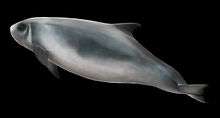 | Kogia sima (Owen, 1866) | Cetacea | Kogiidae | uncommon; marine areas | |
Sperm whale | Physeter macrocephalus Linnaeus, 1758 | Cetacea | Physeteridae | rare; marine areas | |
| Gervais' beaked whale | Mesoplodon europaeus (Gervais, 1855) | Cetacea | Ziphiidae | rare; marine areas | |
Blainville's beaked whale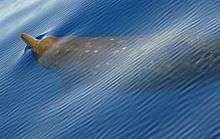 | Mesoplodon densirostris (Blainville, 1817) | Cetacea | Ziphiidae | rare; marine areas | |
True's beaked whale | Mesoplodon mirus True, 1913 | Cetacea | Ziphiidae | rare; Atlantic marine areas south to Flagler County. | |
Cuvier's beaked whale | Ziphius cavirostris G. Cuvier, 1823 | Cetacea | Ziphiidae | rare; marine areas |
References
- General
- Brown, L. N. (1997). Mammals of Florida. Miami, Florida: Windward Publishing.
- Burt, W. H.; R. P. Grossenheider (1976). A field guide to the mammals of America north of Mexico (Third ed.). Boston: Houghton Mifflin Company.
- Nowak, R. M. (1991). Walker's mammals of the world (Fifth ed.). Baltimore, Maryland: The Johns Hopkins University Press.
- Stevenson, H. M. (1976). Vertebrates of Florida, identification and distribution (Fifth ed.). Gainesville, Florida: University Presses of Florida.
- Whitaker, J. O.; W. J. Hamilton (1998). Mammals of the Eastern United States (Third ed.). Ithaca, New York: Cornell University Press.
- "State Lists:Mammals of Florida". The American Society of Mammalogists. 2001-05-22. Retrieved 2007-07-18.
- Specific
- 1 2 "§15.038 2006 Florida Statutes". State of Florida. Retrieved 2007-07-19.
- ↑ "§15.0353 2006 Florida Statutes". State of Florida. Retrieved 2007-07-19.
- 1 2 3 4 5 6 7 "State Lists:Mammals of Florida". The American Society of Mammalogists. 2001-05-22. Retrieved 2007-07-18. The silver rice rat is not in this list because it was reclassified as a synonym of the marsh rice rat (Oryzomys palustris). Besides that, the classification for animals was updated to reflect current nomenclature, and the common names of animals changed to the names used in Wikipedia articles.
- ↑ "Coyote". State of Florida. Archived from the original on 2006-04-20. Retrieved 2007-07-19.
- ↑ "Gray Fox". State of Florida. Archived from the original on 2006-04-28. Retrieved 2007-07-19.
- ↑ "Red Fox". State of Florida. August 2006. Archived from the original on 2006-04-23. Retrieved 2007-07-19.
- ↑ "Public Hearing Scheduled on Expanding Red Wolf Program to Northwest Florida's Little George Island". U.S. Fish and Wildlife Service. February 4, 1997. Retrieved 2007-07-19.
- ↑ U.S. Fish & Wildlife Service. "St. Vincent National Wildlife Refuge Fish, Amphibian, Reptile and Mammal List" (pdf). Retrieved 2007-07-19.
- ↑ "Bobcat". State of Florida. August 2006. Archived from the original on 2006-04-20. Retrieved 2007-07-19.
- ↑ "Physical description". State of Florida. Archived from the original on 2005-04-19. Retrieved 2007-07-19.
- ↑ "Range of the Panther". State of Florida. Archived from the original on 2007-06-30. Retrieved 2007-07-19.
- ↑ "Inbreeding". State of Florida. Archived from the original on 2005-09-07. Retrieved 2007-07-19.
- ↑ "1980". State of Florida. Archived from the original on 2005-09-06. Retrieved 2007-07-19.
- ↑ "Jaguarundi, Felis yagouaroundi". National Park Service.
- ↑ Dan DeWitt (August 12, 2004). "A debate over zoning brings out the big cat". Retrieved 2007-07-19.
- ↑ "Mustela Vison". USDA Forest Service.
- ↑ "Lutra Canadensis". USDA Forest Service. Retrieved 2007-07-19.
- ↑ "Raccoons". University of Florida. Retrieved 2007-07-19.
- ↑ "2003 Florida Sea Turtle Nesting Trends & News from the Archie Carr Refuge". Caribbean Conservation Corporation. Retrieved 2007-07-19.
- ↑ "The "Bear" Facts - Appearance". State of Florida. Retrieved 2007-07-19.
- ↑ "Statewide Assessment of Road Impacts on Bears in Six Study Areas in Florida from May 2001 - September 2003" (PDF). State of Florida. Retrieved 2007-07-19.
- ↑ Sillero-Zubiri, C. & Hoffmann, M. (2004). "Canis latrans". IUCN Red List of Threatened Species. Version 2006. International Union for Conservation of Nature. Retrieved July 19, 2007.
- ↑ Cypher, B.L.; Fuller, T.K. & List, R. (2004). "Urocyon cinereoargenteus". IUCN Red List of Threatened Species. Version 2006. International Union for Conservation of Nature. Retrieved July 19, 2007.
- ↑ Macdonald, D.W. & Reynolds, J.C. (2004). "Vulpes vulpes". IUCN Red List of Threatened Species. Version 2006. International Union for Conservation of Nature. Retrieved July 19, 2007.
- ↑ Kelly, B.T.; Beyer, A. & Phillips, M.K. (2004). "Canis rufus". IUCN Red List of Threatened Species. Version 2006. International Union for Conservation of Nature. Retrieved July 19, 2007.
- ↑ Cat Specialist Group (2002). "Lynx rufus". IUCN Red List of Threatened Species. Version 2006. International Union for Conservation of Nature. Retrieved July 19, 2007.
- ↑ Cat Specialist Group (2002). "Puma concolor". IUCN Red List of Threatened Species. Version 2006. International Union for Conservation of Nature. Retrieved July 19, 2007.
- ↑ Cat Specialist Group (2002). "Herpailurus yaguarondi". IUCN Red List of Threatened Species. Version 2006. International Union for Conservation of Nature. Retrieved July 19, 2007.
- ↑ Mustelid Specialist Group (1996). "Spilogale putorius". IUCN Red List of Threatened Species. Version 2006. International Union for Conservation of Nature. Retrieved July 19, 2007.
- ↑ Mustelid Specialist Group (1996). "Mephitis mephitis". IUCN Red List of Threatened Species. Version 2006. International Union for Conservation of Nature. Retrieved July 19, 2007.
- ↑ Mustelid Specialist Group (1996). "Mustela frenata". IUCN Red List of Threatened Species. Version 2006. International Union for Conservation of Nature. Retrieved July 19, 2007.
- ↑ Mustelid Specialist Group (1996). "Mustela vison". IUCN Red List of Threatened Species. Version 2006. International Union for Conservation of Nature. Retrieved July 19, 2007.
- ↑ Serfass, T.L. (2004). "Lontra canadensis". IUCN Red List of Threatened Species. Version 2006. International Union for Conservation of Nature. Retrieved July 19, 2007.
- ↑ Mustelid Specialist Group (1996). "Procyon lotor". IUCN Red List of Threatened Species. Version 2006. International Union for Conservation of Nature. Retrieved July 19, 2007.
- ↑ Samudio, R.; Kays, R.; Cuarón, A.D.; Pino, J.L. & Helgen, K. (2008). "Nasua narica". IUCN Red List of Threatened Species. Version 2008. International Union for Conservation of Nature. Retrieved 26 January 2009.
- ↑ Bear Specialist Group (1996). "Ursus americanus". IUCN Red List of Threatened Species. Version 2006. International Union for Conservation of Nature. Retrieved July 19, 2007.
- ↑ "Accidental Bat Species in Florida". Florida Bat Conservancy. 2005. Retrieved 2007-07-19.
- 1 2 3 Denise R. Tomlinson. "Florida's Bats". little publishing co. Retrieved 2007-07-19.
- ↑ Chiroptera Specialist Group (1996). "Molossus molossus". IUCN Red List of Threatened Species. Version 2006. International Union for Conservation of Nature. Retrieved July 19, 2007.
- ↑ Chiroptera Specialist Group (1996). "Tadarida brasiliensis". IUCN Red List of Threatened Species. Version 2006. International Union for Conservation of Nature. Retrieved July 19, 2007.
- ↑ Chiroptera Specialist Group (1996). "Eumops glaucinus". IUCN Red List of Threatened Species. Version 2006. International Union for Conservation of Nature. Retrieved July 19, 2007.
- ↑ Chiroptera Specialist Group (1996). "Artibeus jamaicensis". IUCN Red List of Threatened Species. Version 2006. International Union for Conservation of Nature. Retrieved July 19, 2007.
- ↑ Chiroptera Specialist Group (1996). "Eptesicus fuscus". IUCN Red List of Threatened Species. Version 2006. International Union for Conservation of Nature. Retrieved July 19, 2007.
- ↑ Chiroptera Specialist Group (1996). "Pipistrellus subflavus". IUCN Red List of Threatened Species. Version 2006. International Union for Conservation of Nature. Retrieved July 19, 2007.
- ↑ Chiroptera Specialist Group (1996). "Lasiurus borealis". IUCN Red List of Threatened Species. Version 2006. International Union for Conservation of Nature. Retrieved July 19, 2007.
- ↑ Chiroptera Specialist Group (1996). "Nycticeius humeralis". IUCN Red List of Threatened Species. Version 2006. International Union for Conservation of Nature. Retrieved July 19, 2007.
- ↑ Chiroptera Specialist Group (1996). "Myotis grisescens". IUCN Red List of Threatened Species. Version 2006. International Union for Conservation of Nature. Retrieved July 19, 2007.
- ↑ Chiroptera Specialist Group (1996). "Lasiurus cinereus". IUCN Red List of Threatened Species. Version 2006. International Union for Conservation of Nature. Retrieved July 19, 2007.
- ↑ Chiroptera Specialist Group (1996). "Myotis sodalis". IUCN Red List of Threatened Species. Version 2006. International Union for Conservation of Nature. Retrieved July 19, 2007.
- ↑ Chiroptera Specialist Group (1996). "Myotis lucifugus". IUCN Red List of Threatened Species. Version 2006. International Union for Conservation of Nature. Retrieved July 19, 2007.
- ↑ Chiroptera Specialist Group (1996). "Myotis septentrionalis". IUCN Red List of Threatened Species. Version 2006. International Union for Conservation of Nature. Retrieved July 19, 2007.
- ↑ Chiroptera Specialist Group (1996). "Lasiurus intermedius". IUCN Red List of Threatened Species. Version 2006. International Union for Conservation of Nature. Retrieved July 19, 2007.
- ↑ Arroyo-Cabrales, J. & Ticul Alvarez Castaneda, S. (2008). "Corynorhinus rafinesquii". IUCN Red List of Threatened Species. Version 2009.2. International Union for Conservation of Nature. Retrieved 1 February 2010.
- ↑ Chiroptera Specialist Group (1996). "Lasiurus seminolus". IUCN Red List of Threatened Species. Version 2006. International Union for Conservation of Nature. Retrieved July 19, 2007.
- ↑ Chiroptera Specialist Group (1996). "Lasionycteris noctivagans". IUCN Red List of Threatened Species. Version 2006. International Union for Conservation of Nature. Retrieved July 19, 2007.
- ↑ Chiroptera Specialist Group (1996). "Myotis austroriparius". IUCN Red List of Threatened Species. Version 2006. International Union for Conservation of Nature. Retrieved July 19, 2007.
- ↑ Brittany L. Bird; Lyn C. Branch; Mark E. Hostetler. "Beach Mice". University of Florida. Retrieved 2007-07-20.
- ↑ "Florida Mouse (Gopher Mouse) (Podomys floridanus)". United States fauna. Retrieved 2007-07-20.
- 1 2 "Florida's Exotic Wildlife: status for 31 Mammal species". State of Florida. Archived from the original on May 24, 2011. Retrieved 2007-07-20.
- ↑ MacDonald, S.O. & Cook, J.A. (2000). "Castor canadensis". IUCN Red List of Threatened Species. Version 2006. International Union for Conservation of Nature. Retrieved July 19, 2007.
- ↑ Kirkland, G.L. Jr. (1996). "Geomys pinetis". IUCN Red List of Threatened Species. Version 2006. International Union for Conservation of Nature. Retrieved July 19, 2007.
- ↑ Baillie, J. (1996). "Hydrochaeris hydrochaeris". IUCN Red List of Threatened Species. Version 2006. International Union for Conservation of Nature. Retrieved July 19, 2007.
- ↑ Kirkland, G.L. Jr. (1996). "Peromyscus polionotus". IUCN Red List of Threatened Species. Version 2006. International Union for Conservation of Nature. Retrieved July 19, 2007.
- ↑ Kirkland, G.L. Jr. (1996). "Peromyscus gossypinus". IUCN Red List of Threatened Species. Version 2006. International Union for Conservation of Nature. Retrieved July 19, 2007.
- ↑ Baillie, J. (1996). "Reithrodontomys humilis". IUCN Red List of Threatened Species. Version 2006. International Union for Conservation of Nature. Retrieved July 19, 2007.
- ↑ Hafner, D.J. (1996). "Neotoma floridana". IUCN Red List of Threatened Species. Version 2006. International Union for Conservation of Nature. Retrieved July 19, 2007.
- ↑ Hafner, D.J. (1996). "Podomys floridanus". IUCN Red List of Threatened Species. Version 2006. International Union for Conservation of Nature. Retrieved July 19, 2007.
- ↑ Baillie, J. (1996). "Microtus pennsylvanicus". IUCN Red List of Threatened Species. Version 2006. International Union for Conservation of Nature. Retrieved July 19, 2007.
- ↑ Baillie, J. (1996). "Ochrotomys nuttalli". IUCN Red List of Threatened Species. Version 2006. International Union for Conservation of Nature. Retrieved July 19, 2007.
- ↑ Baillie, J. (1996). "Sigmodon hispidus". IUCN Red List of Threatened Species. Version 2006. International Union for Conservation of Nature. Retrieved July 19, 2007.
- ↑ Amori, G. (1996). "Mus musculus". IUCN Red List of Threatened Species. Version 2006. International Union for Conservation of Nature. Retrieved July 19, 2007.
- ↑ Baillie, J. (1996). "Oryzomys palustris". IUCN Red List of Threatened Species. Version 2006. International Union for Conservation of Nature. Retrieved July 19, 2007.
- ↑ Amori, G. (1996). "Rattus norvegicus". IUCN Red List of Threatened Species. Version 2006. International Union for Conservation of Nature. Retrieved July 19, 2007.
- ↑ Rodent Specialist Group (1996). "Microtus pinetorum". IUCN Red List of Threatened Species. Version 2006. International Union for Conservation of Nature. Retrieved July 19, 2007.
- ↑ Amori, G. (1996). "Rattus rattus". IUCN Red List of Threatened Species. Version 2006. International Union for Conservation of Nature. Retrieved July 19, 2007.
- ↑ Kirkland, G.L. Jr. (2000). "Neofiber alleni". IUCN Red List of Threatened Species. Version 2006. International Union for Conservation of Nature. Retrieved July 19, 2007.
- ↑ Pearson, O. (1996). "Myocastor coypus". IUCN Red List of Threatened Species. Version 2006. International Union for Conservation of Nature. Retrieved July 19, 2007.
- ↑ Rodent Specialist Group (1996). "Tamias striatus". IUCN Red List of Threatened Species. Version 2006. International Union for Conservation of Nature. Retrieved July 19, 2007.
- ↑ Baillie, J. (1996). "Sciurus carolinensis". IUCN Red List of Threatened Species. Version 2006. International Union for Conservation of Nature. Retrieved July 19, 2007.
- ↑ Kirkland, G.L. Jr. (2000). "Sciurus niger". IUCN Red List of Threatened Species. Version 2006. International Union for Conservation of Nature. Retrieved July 19, 2007.
- ↑ Baillie, J. (1996). "Sciurus aureogaster". IUCN Red List of Threatened Species. Version 2006. International Union for Conservation of Nature. Retrieved July 19, 2007.
- ↑ Baillie, J. (1996). "Glaucomys volans". IUCN Red List of Threatened Species. Version 2006. International Union for Conservation of Nature. Retrieved July 19, 2007.
- ↑ Schaefer, Joe; Martin B. Main. "White-Tailed Deer of Florida 1". University of Florida, Institute of Food and Agricultural Sciences (UF/IFAS). Retrieved 2007-07-20.
- ↑ Henry Cabbage. "Going after 600-pound sambar deer in Florida!" (pdf). Florida Wildlife Magazine. Retrieved 2007-07-19.
- ↑ "Elk". State of Florida. August 2006. Archived from the original on May 24, 2011. Retrieved 2007-07-19.
- ↑ "Hog Wild In Florida: UF Experts Say Feral Pig Problem Here To Stay". Science Daily. June 7, 2005. Retrieved 2007-07-19.
- 1 2 "Nonindigenous Nonaquatic Mammals of High Visibility". University of Florida, Center for Aquatic & Invasive Plants. 1996. Archived from the original on 2006-09-02. Retrieved 2007-07-19.
- ↑ Marianne Cowley. "Rabbits & Hares". Your Florida Backyard. Retrieved 2007-07-20.
- ↑ Marianne Cowley. "Shrews". Your Florida Backyard. Retrieved 2007-07-20.
- ↑ Veiga, Alex (September 26, 1999). "Florida at war with invasion of foreign species". Polkonline.com. Archived from the original on 2007-09-27. Retrieved 2007-07-20.
- ↑ Pawelski, Natalie (July 10, 1998). "Monkeys raised for research wreak havoc in Florida Keys". CNN. Retrieved 2007-07-20.
- ↑ "Vervet Monkey". State of Florida. Archived from the original on May 24, 2011. Retrieved 2007-07-19.
- ↑ "Squirrel Monkey". State of Florida. Archived from the original on May 24, 2011. Retrieved 2007-07-19.
- ↑ Deer Specialist Group (1996). "Cervus elaphus". IUCN Red List of Threatened Species. Version 2006. International Union for Conservation of Nature. Retrieved July 19, 2007.
- ↑ Deer Specialist Group (1996). "Cervus unicolor". IUCN Red List of Threatened Species. Version 2006. International Union for Conservation of Nature. Retrieved July 19, 2007.
- ↑ Deer Specialist Group (1996). "Odocoileus virginianus". IUCN Red List of Threatened Species. Version 2006. International Union for Conservation of Nature. Retrieved July 19, 2007.
- ↑ Pigs & Peccaries Specialist Group (1996). "Sus scrofa". IUCN Red List of Threatened Species. Version 2006. International Union for Conservation of Nature. Retrieved July 19, 2007.
- ↑ Edentate Specialist Group (2006). "Dasypus novemcinctus". IUCN Red List of Threatened Species. Version 2006. International Union for Conservation of Nature. Retrieved July 19, 2007.
- ↑ New World Marsupial Specialist Group (1996). "Didelphis virginiana". IUCN Red List of Threatened Species. Version 2006. International Union for Conservation of Nature. Retrieved July 19, 2007.
- ↑ Lagomorph Specialist Group (1996). "Lepus californicus". IUCN Red List of Threatened Species. Version 2006. International Union for Conservation of Nature. Retrieved July 19, 2007.
- ↑ Lagomorph Specialist Group (1996). "Sylvilagus floridanus". IUCN Red List of Threatened Species. Version 2006. International Union for Conservation of Nature. Retrieved July 19, 2007.
- ↑ Lagomorph Specialist Group (1996). "Sylvilagus palustris". IUCN Red List of Threatened Species. Version 2006. International Union for Conservation of Nature. Retrieved July 19, 2007.
- ↑ Lagomorph Specialist Group (1996). "Sylvilagus aquaticus". IUCN Red List of Threatened Species. Version 2006. International Union for Conservation of Nature. Retrieved July 19, 2007.
- ↑ Eudey, A. & Members of the Primate Specialist Group (2000). "Macaca mulatta". IUCN Red List of Threatened Species. Version 2006. International Union for Conservation of Nature. Retrieved July 19, 2007.
- ↑ Insectivore Specialist Group (1996). "Cryptotis parva". IUCN Red List of Threatened Species. Version 2006. International Union for Conservation of Nature. Retrieved July 19, 2007.
- ↑ Insectivore Specialist Group (1996). "Sorex longirostris". IUCN Red List of Threatened Species. Version 2006. International Union for Conservation of Nature. Retrieved July 19, 2007.
- ↑ Insectivore Specialist Group (1996). "Blarina carolinensis". IUCN Red List of Threatened Species. Version 2006. International Union for Conservation of Nature. Retrieved July 19, 2007.
- ↑ Insectivore Specialist Group (1996). "Scalopus aquaticus". IUCN Red List of Threatened Species. Version 2006. International Union for Conservation of Nature. Retrieved July 19, 2007.
- ↑ Insectivore Specialist Group (1996). "Condylura cristata". IUCN Red List of Threatened Species. Version 2006. International Union for Conservation of Nature. Retrieved July 19, 2007.
- ↑ "Manatee". State of Florida. Retrieved 2007-07-19.
- ↑ "Manatees". Fish and Wildlife Research Institute. Retrieved 2015-08-20.
- ↑ United Press International (May 5, 2007). "Bearded seal strays from Arctic to Florida". Science Daily. Archived from the original on 2007-09-30. Retrieved 2007-07-19.
- ↑ Animals (November–December 1997). "Ghost of a monk seal: has the Caribbean monk seal barked its final good-bye?". FindArticles.com. Retrieved 2007-07-19.
- ↑ Seal Specialist Group (1996). "Phoca vitulina". IUCN Red List of Threatened Species. Version 2006. International Union for Conservation of Nature. Retrieved July 19, 2007.
- ↑ Seal Specialist Group (1996). "Cystophora cristata". IUCN Red List of Threatened Species. Version 2006. International Union for Conservation of Nature. Retrieved July 19, 2007.
- ↑ Seal Specialist Group (1996). "Monachus tropicalis". IUCN Red List of Threatened Species. Version 2006. International Union for Conservation of Nature. Retrieved July 19, 2007.
- ↑ Sirenia Specialist Group (1996). "Trichechus manatus". IUCN Red List of Threatened Species. Version 2006. International Union for Conservation of Nature. Retrieved July 19, 2007.
- ↑ "North Atlantic Right Whales". Fish and Wildlife Research Institute. Retrieved 2007-07-21.
- ↑ Mead JG, Mitchell ED (1984). "Atlantic gray whales". In Jones ML, Swartz SL, Leatherwood S. The Gray Whale. London: Academic Press. pp. 33–53.
- ↑ "Red Tide Toxins Pose Lingering Threat to Marine Mammals". August 4, 2005. Archived from the original on November 26, 2006. Retrieved 2007-07-21.
- ↑ "State Symbols". The Florida Legislature. Retrieved 2007-07-21.
- ↑ Cetacean Specialist Group (1996). "Eubalaena glacialis". IUCN Red List of Threatened Species. Version 2006. International Union for Conservation of Nature. Retrieved July 19, 2007.
- ↑ Cetacean Specialist Group (1996). "Eschrichtius robustus". IUCN Red List of Threatened Species. Version 2006. International Union for Conservation of Nature. Retrieved July 19, 2007.
- ↑ Cetacean Specialist Group (1996). "Balaenoptera edeni". IUCN Red List of Threatened Species. Version 2006. International Union for Conservation of Nature. Retrieved July 19, 2007.
- ↑ Cetacean Specialist Group (1996). "Balaenoptera physalus". IUCN Red List of Threatened Species. Version 2006. International Union for Conservation of Nature. Retrieved July 19, 2007.
- ↑ Cetacean Specialist Group (1996). "Balaenoptera musculus". IUCN Red List of Threatened Species. Version 2006. International Union for Conservation of Nature. Retrieved July 19, 2007.
- ↑ Cetacean Specialist Group (1996). "Balaenoptera acutorostrata". IUCN Red List of Threatened Species. Version 2006. International Union for Conservation of Nature. Retrieved July 19, 2007.
- ↑ Cetacean Specialist Group (1996). "Balaenoptera borealis". IUCN Red List of Threatened Species. Version 2006. International Union for Conservation of Nature. Retrieved July 19, 2007.
- ↑ Cetacean Specialist Group (1996). "Megaptera novaeangliae". IUCN Red List of Threatened Species. Version 2006. International Union for Conservation of Nature. Retrieved July 19, 2007.
- ↑ Cetacean Specialist Group (1996). "Stenella frontalis". IUCN Red List of Threatened Species. Version 2006. International Union for Conservation of Nature. Retrieved July 19, 2007.
- ↑ Cetacean Specialist Group (1996). "Stenella attenuata". IUCN Red List of Threatened Species. Version 2006. International Union for Conservation of Nature. Retrieved July 19, 2007.
- ↑ Cetacean Specialist Group (1996). "Stenella coeruleoalba". IUCN Red List of Threatened Species. Version 2006. International Union for Conservation of Nature. Retrieved July 19, 2007.
- ↑ Cetacean Specialist Group (1996). "Stenella clymene". IUCN Red List of Threatened Species. Version 2006. International Union for Conservation of Nature. Retrieved July 19, 2007.
- ↑ Cetacean Specialist Group (1996). "Stenella longirostris". IUCN Red List of Threatened Species. Version 2006. International Union for Conservation of Nature. Retrieved July 19, 2007.
- ↑ Cetacean Specialist Group (1996). "Tursiops truncatus". IUCN Red List of Threatened Species. Version 2006. International Union for Conservation of Nature. Retrieved July 19, 2007.
- ↑ Cetacean Specialist Group (1996). "Delphinus delphis". IUCN Red List of Threatened Species. Version 2006. International Union for Conservation of Nature. Retrieved July 19, 2007.
- ↑ Cetacean Specialist Group (1996). "Pseudorca crassidens". IUCN Red List of Threatened Species. Version 2006. International Union for Conservation of Nature. Retrieved July 19, 2007.
- ↑ Cetacean Specialist Group (1996). "Feresa attenuata". IUCN Red List of Threatened Species. Version 2006. International Union for Conservation of Nature. Retrieved July 19, 2007.
- ↑ Cetacean Specialist Group (1996). "'". IUCN Red List of Threatened Species. Version 2006. International Union for Conservation of Nature. Retrieved July 19, 2007.
- ↑ Cetacean Specialist Group (1996). "'". IUCN Red List of Threatened Species. Version 2006. International Union for Conservation of Nature. Retrieved July 19, 2007.
- ↑ Cetacean Specialist Group (1996). "Grampus griseus". IUCN Red List of Threatened Species. Version 2006. International Union for Conservation of Nature. Retrieved July 19, 2007.
- ↑ Cetacean Specialist Group (1996). "Orcinus orca". IUCN Red List of Threatened Species. Version 2006. International Union for Conservation of Nature. Retrieved July 19, 2007.
- ↑ Cetacean Specialist Group (1996). "Steno bredanensis". IUCN Red List of Threatened Species. Version 2006. International Union for Conservation of Nature. Retrieved July 19, 2007.
- ↑ Cetacean Specialist Group (1996). "Globicephala macrorhynchus". IUCN Red List of Threatened Species. Version 2006. International Union for Conservation of Nature. Retrieved July 19, 2007.
- ↑ Cetacean Specialist Group (1996). "Kogia breviceps". IUCN Red List of Threatened Species. Version 2006. International Union for Conservation of Nature. Retrieved July 19, 2007.
- ↑ Cetacean Specialist Group (1996). "Kogia sima". IUCN Red List of Threatened Species. Version 2006. International Union for Conservation of Nature. Retrieved July 19, 2007.
- ↑ Cetacean Specialist Group (1996). "Physeter macrocephalus". IUCN Red List of Threatened Species. Version 2006. International Union for Conservation of Nature. Retrieved July 19, 2007.
- ↑ Cetacean Specialist Group (1996). "Mesoplodon europaeus". IUCN Red List of Threatened Species. Version 2006. International Union for Conservation of Nature. Retrieved July 19, 2007.
- ↑ Cetacean Specialist Group (1996). "Mesoplodon densirostris". IUCN Red List of Threatened Species. Version 2006. International Union for Conservation of Nature. Retrieved July 19, 2007.
- ↑ Cetacean Specialist Group (1996). "Mesoplodon mirus". IUCN Red List of Threatened Species. Version 2006. International Union for Conservation of Nature. Retrieved July 19, 2007.
- ↑ Cetacean Specialist Group (1996). "Ziphius cavirostris". IUCN Red List of Threatened Species. Version 2006. International Union for Conservation of Nature. Retrieved July 19, 2007.
